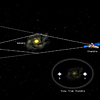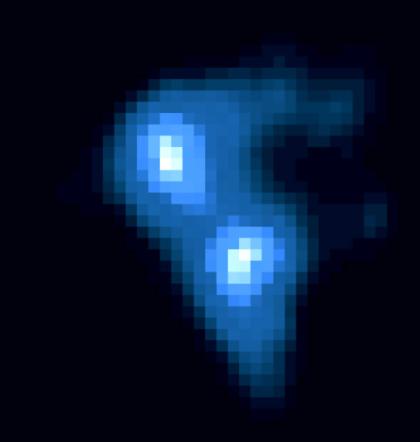Matter Near Black Hole Gets Second Lease On Life
Chandra observations reveal evidence of high-speed winds blowing gas away from the supermassive black hole that powers the quasar APM 08279+5255. This discovery suggests that such winds may play a key role in regulating the growth of supermassive black holes in the centers of galaxies.
The Chandra data imply that the wind is blowing away from the black hole at speeds as high as 40 percent of the speed light, considerably faster than predicted. As gas swirls in a disk toward the black hole, it is heated to millions of degrees Celsius and produces intense X-radiation. The pressure of the X-rays pushes matter away from the inner part of the disk in much the same way as pressure from a garden hose pushes dirt off a driveway. This radiation pressure effect can significantly limit the amount of matter captured by the black hole.
The double image of APM 08279 is caused by the bending of its light by an intervening galaxy, an effect called gravitational lensing. This effect also magnifies the light of the quasar 100 fold allowing for a detailed study of its properties even though it is 12 billion light.
|
||||||||||||||||||||||||||
The image is an X-ray astronomical image of quasar APM 08279+5255, which is a galaxy with a supermassive black hole at its center. The image appears to be in shades of purple and blue, with a circular shape that resembles a spinning vortex or a tornado. The image also includes a smaller circle on the right side, which might represent another celestial object or a different part of the quasar's structure. Key structures in the image include the supermassive black hole at the center, as well as the accretion disk surrounding it. The accretion disk is composed of gas and dust that are being pulled towards the black hole due to its immense gravitational pull. This process heats up the gas and dust, causing it to emit X-rays that can be detected by telescopes like Chandra X-ray Observatory. Compared to familiar everyday objects, the X-ray astronomical image of quasar APM 08279+5255 resembles a spinning vortex or a tornado, reminiscent of natural phenomena such as hurricanes or whirlpools.





